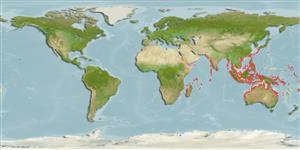Common names from other countries
Environment: milieu / climate zone / depth range / distribution range
বাস্তুসংস্থান
; গভীরতার পরিসীমা 0 - 30 m (Ref. 348). Tropical
Indo-West Pacific: probably from Madagascar to the Philippines; north to China and south to northern Australia. Note that the exact distribution is not known because of persistent confusion with other species.
Length at first maturity / আকৃতি / ওজন / Age
Maturity: Lm ? range ? - ? cm Max length : 5.0 cm SHL পুরুষ/ লিঙ্গ অনিধর্ারিত ; (Ref. 348); common length : 4.0 cm SHL পুরুষ/ লিঙ্গ অনিধর্ারিত ; (Ref. 348)
Often occurring gregariously, both on hard and soft substrates, and producing large quantities of byssal threads that generally enclose various small hard objects. Littoral and sublittoral to a depth of about 30 m (Ref. 348).
Life cycle and mating behavior
পরিপক্কতা | প্রজনন | ডিম ছাড়া | ডিমসমূহ | ডিম্বধারন ক্ষমতা | শুককীট
Members of the class Bivalvia are mostly gonochoric, some are protandric hermaphrodites. Life cycle: Embryos develop into free-swimming trocophore larvae, succeeded by the bivalve veliger, resembling a miniature clam.
Poutiers, J.M. 1998. (Ref. 348)
IUCN Red List Status (Ref. 130435)
CITES status (Ref. 108899)
Not Evaluated
Not Evaluated
Threat to humans
Harmless
Human uses
| FishSource |
হাতিয়ার
ইন্টারনেট সুত্র
Estimates based on models
Preferred temperature
(Ref.
115969): 23.6 - 29.2, mean 28.5 (based on 2876 cells).
Vulnerability
Low vulnerability (10 of 100).
